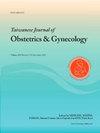使用迪诺前列酮阴道插入剂后,对宫颈成熟不良进行机械扩张,缩短子宫强张给药时间
IF 2
4区 医学
Q2 OBSTETRICS & GYNECOLOGY
引用次数: 0
摘要
目的探讨迪诺前列石阴道插入器(DVI)与宫颈机械扩张联合应用于宫颈成熟不良引产的临床疗效。我们进行了一项回顾性观察研究,旨在评估这种方法在引产中的效果。材料和方法分析71例Bishop评分0-2分的DVI孕妇的临床特点,探讨DVI使用后是否需要额外机械扩张的临床因素,以及是否因分娩进展而移除DVI。进一步的分析集中在43名妇女的亚组中,这些妇女因怀孕后进行了引产并伴有DVI。将DVI组的分娩结果与历史对照组71例因产后妊娠而进行机械扩张而无DVI的妇女进行比较。结果在71名接受DVI治疗的女性中,38名不需要额外的机械扩张,24名在分娩进展后切除了DVI。较低的孕前体重指数与DVI疗效显著相关。对照组与DVI组阴道分娩成功率相当,但DVI组给药时间短于对照组(13.9 h vs 29.2 h, p = 0.01)。结论低BMI是促进DVI有效的因素之一。在宫颈成熟程度极低的人群中,采用DVI联合机械扩张器的宫颈成熟入路减少了子宫强直给药的时间。本文章由计算机程序翻译,如有差异,请以英文原文为准。
Use of dinoprostone vaginal insert followed by mechanical dilation for poor cervical maturation shorten the time length for uterotonics administration
Objective
The clinical efficacy of the combined usage of a dinoprostone vaginal insert (DVI) with mechanical cervical dilatation for the labor induction with poor cervical maturation has not been established. A retrospective observational study was conducted aiming to evaluate the efficacy of this approach on labor induction.
Materials and methods
The clinical features of 71 pregnant women with Bishop score of 0–2 treated with DVI were analyzed to identify the clinical factors associated with the necessity for additional mechanical dilation after DVI use and whether DVI was removed due to labor progression. Further analysis was focused on the subgroup of 43 women who went through labor induction with DVI due to post-date pregnancy. The delivery outcome of DVI group was compared with the historical control group of 71 women who underwent mechanical dilatation without DVI due to post-date pregnancy.
Results
Among the 71 women treated with DVI, 38 did not require additional mechanical dilation and 24 had DVI removed after labor progressed. Lower pre-pregnancy body mass index was significantly associated with DVI efficacy. Whereas the success rate for vaginal delivery was comparable between Control group and DVI group, the time duration of uterotonics administration was shorter in DVI group than that in the Control group (13.9 h vs 29.2 h, p = 0.01).
Conclusion
Low BMI was a factor that facilitates the effectiveness of DVI. A cervical maturation approach using DVI in combination with a mechanical dilator reduced the time of uterotonics administration among populations with extremely poor cervical maturation.
求助全文
通过发布文献求助,成功后即可免费获取论文全文。
去求助
来源期刊

Taiwanese Journal of Obstetrics & Gynecology
OBSTETRICS & GYNECOLOGY-
CiteScore
3.60
自引率
23.80%
发文量
207
审稿时长
4-8 weeks
期刊介绍:
Taiwanese Journal of Obstetrics and Gynecology is a peer-reviewed journal and open access publishing editorials, reviews, original articles, short communications, case reports, research letters, correspondence and letters to the editor in the field of obstetrics and gynecology.
The aims of the journal are to:
1.Publish cutting-edge, innovative and topical research that addresses screening, diagnosis, management and care in women''s health
2.Deliver evidence-based information
3.Promote the sharing of clinical experience
4.Address women-related health promotion
The journal provides comprehensive coverage of topics in obstetrics & gynecology and women''s health including maternal-fetal medicine, reproductive endocrinology/infertility, and gynecologic oncology. Taiwan Association of Obstetrics and Gynecology.
 求助内容:
求助内容: 应助结果提醒方式:
应助结果提醒方式:


